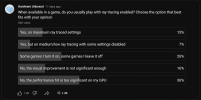So what if it influences his choice of benchmarks? Benchmarks point isn't to paint some pretty picture specific vendor wants. Their point is to benchmark chosen titles at chosen settings, no matter what those titles and settings are. You could bench all the cards with ADOM or Nethack of all things and it would be completely ok.Of course he’s entitled to his opinions and as a pretty large channel we’re entitled to comment on his content. If you think his very vocal personal opinions don’t influence his choice of benchmarks well you’re very generous. You can just look at his reviews and recommendations and know that they do.
Install the app
How to install the app on iOS
Follow along with the video below to see how to install our site as a web app on your home screen.
Note: This feature may not be available in some browsers.
You are using an out of date browser. It may not display this or other websites correctly.
You should upgrade or use an alternative browser.
You should upgrade or use an alternative browser.
Value of Hardware Unboxed benchmarking
- Thread starter Phantom88
- Start date
So what if it influences his choice of benchmarks? Benchmarks point isn't to paint some pretty picture specific vendor wants. Their point is to benchmark chosen titles at chosen settings, no matter what those titles and settings are. You could bench all the cards with ADOM or Nethack of all things and it would be completely ok.
He’s free to do and say whatever he wants. Nobody is contesting that. We are also free to share our opinions about whatever he says and does.
It’s not like these guys are hiding their negativity and resistance to new features. They openly acknowledged it in their latest podcasts. So there’s no need to pretend it’s not happening if it’s coming straight from the horse's mouth.
You can render a single face lit by a single light and say it would be a fair benchmark.Heck, one could bench everything at 640x480 lowest settings and it would still be fair
What value would a benchmark like that provide though...?
A fair benchmark that equalizes/trivializes performance?
There is a balance between fair, and valuable.
Right now, I believe, it is very hard to find that balance.
I guess, a more usage oriented approach would be more valuable than raw numbers in my opinion.
Focus on either image quality, or high framerates, or "budget, down to earth" settings...
There is a balance between fair, and valuable.
Right now, I believe, it is very hard to find that balance.
I guess, a more usage oriented approach would be more valuable than raw numbers in my opinion.
Focus on either image quality, or high framerates, or "budget, down to earth" settings...
I think fairness should be evaluated in context of the claimed goal of the content. HUB reviews video cards and makes recommendations to potential buyers. They do this in individual reviews and in roundups. We can only assume that their target market is all gamers buying discrete GPUs. They don’t claim to be IQ buffs or fans of optimized settings so their content doesn’t reflect that and that’s fine.
The main issue with HUB content is their value system and recommendations don’t seem to vibe with the market they’re supposedly targeting. If they were to say their target market is people who don’t care about raytracing or upscaling for example then their content would make a lot more sense.
I guess, that is the audience, give or take, they claim they represent.If they were to say their target market is people who don’t care about raytracing or upscaling for example then their content would make a lot more sense.
It doesn't make sense to me.
"Native" rendering, high IQ without (new as opposed to old) artifacts, high framerates and cheap hardware, sounds like wishful thinking based on unattainable standards...
There is no "perfect", you'll have to make choices even with the latest and greatest.
Or, you can stick to the same old same old.
If we fought the first TFT monitors (objectively worse than CRTs), with all our might, I guess we'd be rocking a 45 inch 1,5 meter by 1 meter 250 kg box on gaming desks made of steel...
At least it didn't take 30 years for dlss to be actually good instead of simply serviceable.
They have, they've polled their audience on it a year back.The main issue with HUB content is their value system and recommendations don’t seem to vibe with the market they’re supposedly targeting. If they were to say their target market is people who don’t care about raytracing or upscaling for example then their content would make a lot more sense.

They have, they've polled their audience on it a year back.
View attachment 13017
Maybe my math is off but it looks like a 50/50 split in that poll of usage and only 16% think RT isn’t impactful enough.
But let’s assume that’s their target market and therefore native raster perf/$ is the appropriate metric. Their latest recommendation is that AMD should charge at least 25% less than Nvidia for equivalent raster performance in order for their audience to buy AMD. Why is that discount necessary if their audience only cares about raster performance?
The results of that poll seem reasonable to me given the current state of the Steam hardware survey. IMO raytracing is of dubious value to anything under a 3080/4070. It usually runs too slow and uses too much memory on 8GB cards, and if you wanna bring it up with FG well that uses even more memory. Maybe the new FG model will bring memory usage down in a meaningful way for 8GB users.They have, they've polled their audience on it a year back.
View attachment 13017
Flappy Pannus
Veteran
They missed an analysis of using just native game denoisers (without RR).
May be a separate video, that's how Alex is handling it on DF.
The performance hit from the transformer upscaling model can be significant on my 3060, can vary per game but often performance mode DLSS4 is only slightly faster than Quality mode DLSS3, so it's utility as a 'free upgrade' may be lessened somewhat on older generation cards.
...but when I meet that sweet spot criteria - such as Death Stranding - where Quality mode DLSS3 was out of reach for 4K 60 so had to settle for performance mode anyway, DLSS4 - whoa. Perhaps not perfect (still has issues if motion blur is enabled), but what an upgrade.
Last edited:
DegustatoR
Legend
The fact that only 4090 and 5090 manage more than 60 fps in 4K with "experimental" preset is a fun thing though considering the performance hit it has for what is pretty much zero improvement to graphics. You'd think this is where some RT would be beneficial but apparently this is somehow better according to Steve.and he can see high FPS numbers
Also game's using SVOGI which is a form of RT so the "no RT" claim is a bit false. "No DXR" would be a better label.
It's just sacrificing visual quality for more performance. The draw distance is impressive, but the texture quality, asset quality and lighting is nothing to write home about and does appear a bit last-gen-y. The ground is really flat, the difference to new titles on UE5 is staggering. But I guess the mass market doesn't care about micro level detail and thus, this appears to be more optimized for them.
I don't mind KCD2 looking a little last gen but the two things really stand out to me: SSR reflections disappearing and blocky/noise/aliasing shadows on faces. For the face shadows they could at least go for screen space contact shadows, I remember previous Crytek using those.
I've lost my frame of reference for performance. 1440p ultra is 73 fps on the 3080. I'm trying to decide if that's actually really good performance or not.
Given the quality you're getting for that performance level, it's hot garbage.
Given the quality you're getting for that performance level, it's hot garbage.
Hellblade 2 gets 50 fps at 1440p max settings on a 3080. Not really comparable games, as Hellblade is very on-rails. Alan Wake 2 is 64 fps, max settings and no RT. I'm not really sure how people decide what they mean by optimized.
Hellblade 2 gets 50 fps at 1440p max settings on a 3080. Not really comparable games, as Hellblade is very on-rails. Alan Wake 2 is 64 fps, max settings and no RT. I'm not really sure how people decide what they mean by optimized.
Well for Steve, it doesn’t have RT so it’s automatically optimized.
I bet he will ignore the obvious render errors/artifacts too.Well for Steve, it doesn’t have RT so it’s automatically optimized.
Given the quality you're getting for that performance level, it's hot garbage.
I guess it's more about scaling down to low end cards, or just downright old cards.
Similar threads
- Replies
- 166
- Views
- 11K
- Replies
- 135
- Views
- 19K
- Replies
- 10
- Views
- 1K
- Replies
- 3
- Views
- 795
- Replies
- 51
- Views
- 3K


